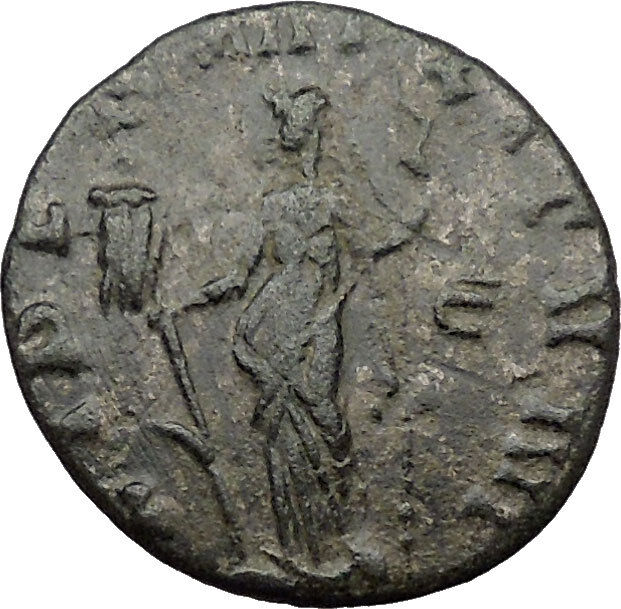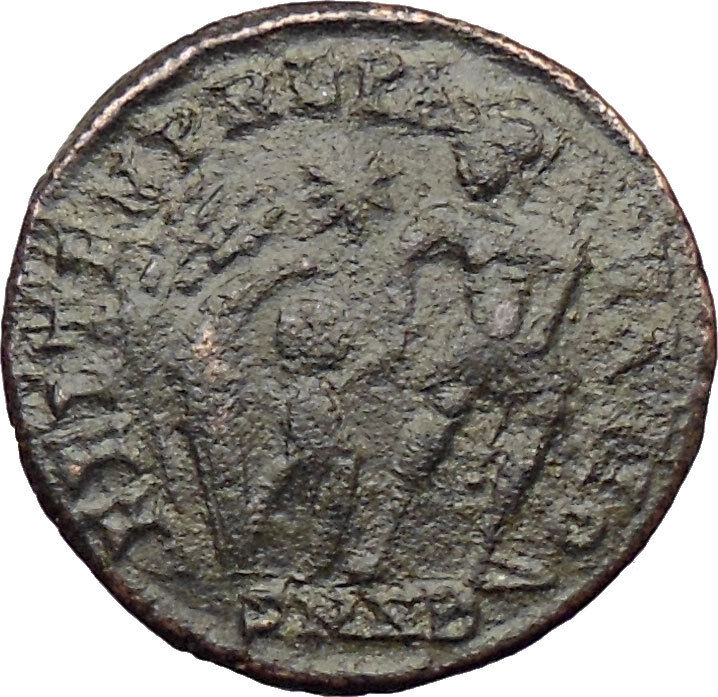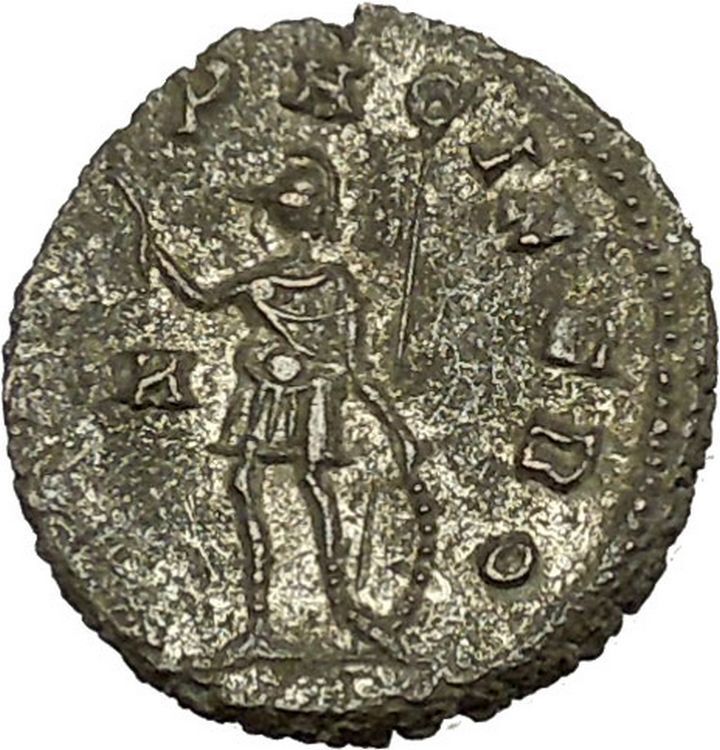|
Maximian
–
Roman Emperor
: 285-305, 306-308 & 310 A.D. –
Silvered Bronze Antoninianus 22mm (3.55 grams) Lyons mint: 290-294 A.D.
Reference: RIC V-II, Lyons 399 helmeted
IMP MAXIMIANVS AVG, helmeted, radiate, cuirassed bust right
PAX AVGG, Pax standing left, holding Victory on globe and transverse
sceptre.
Officina letter B in exergue.
You are bidding on the exact
item pictured, provided with a Certificate of Authenticity and Lifetime
Guarantee of Authenticity.
Eirene, or Irene Greek for “peace”; the
Roman
equivalent was
Pax
, one of the
Horae
, was the personification of peace, and
was depicted in art as a beautiful young woman carrying a
cornucopia
,
sceptre
and a torch or
rhyton
. She is said sometimes to be the
daughter of Zeus
and
Themis
.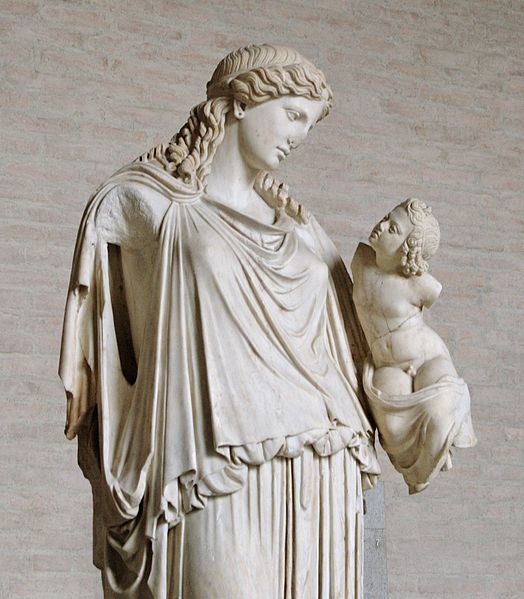
She was particularly well regarded by the
citizens of Athens
. After a naval victory over
Sparta
in 375 BC, the Athenians established a
cult for Eirene, erecting
altars
to her. They held an annual state
sacrifice to her after 371 BC to commemorate the
Common Peace
of that year and set up a votive
statue in her honour in the
Agora of Athens
. The statue was executed in
bronze by
Cephisodotus the Elder
, likely the father or
uncle of the famous sculptor
Praxiteles
. It was acclaimed by the Athenians,
who depicted it on vases and coins.
Although the statue is now lost, it was copied in marble by the Romans; one
of the best surviving copies (right) is in the
Munich
Glyptothek
. It depicts the goddess carrying a
child with her left arm –
Ploutos
, the god of plenty and son of
Demeter
, the goddess of agriculture. Eirene’s
missing right hand once held a sceptre. She is shown gazing maternally at
Ploutos, who is looking back at her trustingly. The statue is an allegory for
Plenty (Ploutos) prospering under the protection of Peace (Eirene); it
constituted a public appeal to good sense. The copy in the Glyptothek was
originally in the collection of the
Villa Albani
in Rome but was looted and taken
to France by
Napoleon I
. Following Napoleon’s fall, the
statue was bought by
Ludwig I of Bavaria
.

In
Roman mythology
, Pax (Latin
for peace
) (her
Greek
equivalent was
Eirene
) was recognized as a
goddess
during the rule of
Augustus
. On the
Campus Martius
, she had a temple called the
Ara Pacis
, and another temple on the
Forum Pacis
. She was depicted in art with
olive
branches, a
cornucopia
and a scepter. There was a festival
in her honor on January 3. Daughter of
Jupiter
and
Iustitia
. Pax was often associated with spring.
|
Maximian |
52nd Emperor
of
the Roman
Empire |

Bust of Emperor Maximian |
| Reign |
July 21 or
July 25 285 – 286 (as Caesar underDiocletian)
April 2, 286 – May 1, 305 (as Augustus of the West, with Diocletian as
Augustus of the East)
Late 306 – November 11, 308 (declared himself Augustus)
310 (declared himself Augustus) |
| Full name |
Marcus Aurelius
Valerius Maximianus Herculius Augustus |
| Born |
ca. 250 |
|
Birthplace |
Sirmium
|
| Died |
ca. July 310 (aged 60) |
Place of
death |
Massilia (Marseille, France) |
|
Predecessor |
Numerian
|
| Successor |
Constantius Chlorus
andGalerius |
Consort
to |
Eutropia
|
| Issue |
Flavia Maximiana Theodora
Maxentius
Fausta
|
Maximian (Latin: Marcus
Aurelius Valerius Maximianus Herculius Augustus; c.
250 – c. July 310) was Roman
Emperor from 286 to 305.
He was Caesar from
285 to 286, then Augustus from
286 to 305. He
shared the latter title with his co-emperor and superior, Diocletian,
whose political brain complemented Maximian’s military brawn. Maximian
established his residence at Trier but
spent most of his time on campaign. In the late summer of 285, he suppressed
rebels in Gaul known as the Bagaudae.
From 285 to 288, he fought against Germanic
tribes along the Rhine frontier.
Together with Diocletian, he launched a scorched
earth campaign deep into Alamannic territory
in 288, temporarily relieving the Rhine provinces from the threat of Germanic
invasion.
The man he appointed to police the Channel shores, Carausius,
rebelled in 286, causing the secession of Britain and northwestern Gaul.
Maximian failed to oust Carausius, and his invasion fleet was destroyed by
storms in 289 or 290. Maximian’s subordinate, Constantius,
campaigned against Carausius’ successor, Allectus,
while Maximian held the Rhine
frontier. The rebel leader was ousted in 296, and Maximian moved
south to combat piracy near Hispania and Berber incursions
inMauretania.
When these campaigns concluded in 298, he departed for Italy, where he lived in
comfort until 305. At Diocletian’s behest, Maximian abdicated on May 1, 305,
gave the Augustan office to Constantius, and retired to southern Italy.
In late 306, Maximian took the title of Augustus again and aided his son Maxentius‘
rebellion in Italy. In April 307, he attempted to depose his son, but failed and
fled to the court of Constantius’ successor, Constantine (who
was both Maximian’s step-grandson and also his son-in-law), in Trier. At the
Council of Carnuntum in
November 308, Diocletian and his successor, Galerius,
forced Maximian to renounce his imperial claim again. In early 310, Maximian
attempted to seize Constantine’s title while the emperor was on campaign on the
Rhine. Few supported him, and he was captured by Constantine in Marseille.
Maximian committed suicide in the summer of 310 on Constantine’s orders. During
Constantine’s war with Maxentius, Maximian’s image was purged from all public
places. However, after Constantine ousted and killed Maxentius, Maximian’s image
was rehabilitated, and he was deified.
Early life
Maximian was born near Sirmium (modern Sremska
Mitrovica, Serbia)
in the province of Pannonia,
around 250 into the family of shopkeepers. Beyond
that, the ancient sources contain vague allusions to Illyricum as
his homeland, to his Pannonian
virtues, and to his harsh upbringing
along the war-torn Danube frontier. Maximian
joined the army, serving with Diocletian under the emperors Aurelian(r.
270–275) and Probus (r.
276–282). He probably participated in the Mesopotamian campaign of Carus in
283 and attended Diocletian’s election as emperor on November 20, 284 at Nicomedia.
Maximian’s swift appointment by Diocletian as Caesar is
taken by the writer Stephen Williams and historian Timothy
Barnes to mean that the
two men were longterm allies, that their respective roles were pre-agreed and
that Maximian had probably supported Diocletian during his campaign against Carinus (r.
283–285) but there is no direct evidence for this.
With his great energy, firm aggressive character and disinclination to rebel,
Maximian was an appealing candidate for imperial office. The fourth-century
historian Aurelius
Victor described Maximian
as “a colleague trustworthy in friendship, if somewhat boorish, and of great
military talents”. Despite his other
qualities, Maximian was uneducated and preferred action to thought. The panegyric of
289, after comparing his actions to Scipio
Africanus‘ victories over Hannibal during
the Second
Punic War, suggested that Maximian had never heard of them. His
ambitions were purely military; he left politics to Diocletian. The Christian rhetor Lactantius suggested
that Maximian shared Diocletian’s basic attitudes but was less puritanical in
his tastes, and took advantage of the sensual opportunities his position as
emperor offered. Lactantius charged
that Maximian defiled senators’ daughters and traveled with young virgins to
satisfy his unending lust, though Lactantius’ credibility is undermined by his
general hostility towards pagans.
Maximian had two children with his Syrian wife, Eutropia: Maxentius and Fausta.
There is no direct evidence in the ancient sources for their birthdates. Modern
estimates of Maxentius’ birth year have varied from c. 277 to c. 287, and most
date Fausta’s birth to c. 298. Theodora,
the wife of Constantius Chlorus, is often called Maximian’s stepdaughter by
ancient sources, leading to claims by Otto
Seeck and Ernest Stein
that she was born from an earlier marriage between Eutropia and Afranius
Hannibalianus. Barnes challenges this
view, saying that all “stepdaughter” sources derive their information from the
partially unreliable work of history Kaisergeschichte,
while other, more reliable sources, refer to her as Maximian’s natural daughter. Barnes
concludes that Theodora was born no later than c. 275 to an unnamed earlier wife
of Maximian, possibly one of Hannibalianus’ daughters.
Appointment as Caesar
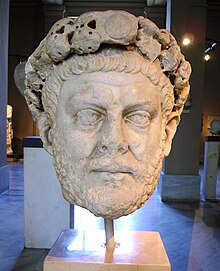
Diocletian, Maximian’s senior colleague and Augustus in the east
At Mediolanum (Milan, Italy)
in July 285, Diocletian proclaimed
Maximian as his co-ruler, or Caesar. The
reasons for this decision are complex. With conflict in every province of the
Empire, from Gaul to Syria, from Egypt to the lower Danube, Diocletian needed a
lieutenant to manage his heavy workload. Historian
Stephen Williams suggests that Diocletian considered himself a mediocre general
and needed a man like Maximian to do most of his fighting.
Next, Diocletian was vulnerable in that he had no sons, just a daughter,
Valeria, who could never succeed him. He was forced therefore to seek a co-ruler
from outside his family and that co-ruler had to be someone he trusted. (The
historian William Seston has argued that Diocletian, like heirless emperors
before him, adopted Maximian as his filius
Augusti (“Augustan son”) upon his
appointment to the office. Some agree, but the historian Frank
Kolb has stated that
arguments for the adoption are based on misreadings of the papyrological
evidence. Maximian did take
Diocletian’s nomen (family
name) Valerius, however.)
Finally, Diocletian knew that single rule was dangerous and that precedent
existed for dual rulership. Despite their military prowess, both sole-emperors
Aurelian and Probus had been easily removed from power. In
contrast, just a few years earlier, the emperor Carus and
his sons had ruled jointly, albeit not for long. Even the first emperor, Augustus,
(r. 27 BC–AD 19), had shared power with his colleagues and more formal offices
of co-emperor had existed from Marcus
Aurelius (r. 161–180) on.
The dual system evidently worked well. About 287, the two rulers’ relationship
was re-defined in religious terms, with Diocletian assuming the title Iovius and
Maximian Herculius. The
titles were pregnant with symbolism: Diocletian-Jove had
the dominant role of planning and commanding; Maximian-Hercules the heroic role
of completing assigned tasks. Yet
despite the symbolism, the emperors were not “gods” in the Imperial
cult (although they may
have been hailed as such in Imperial panegyrics). Instead, they were the gods’
instruments, imposing the gods’ will on earth. Once
the rituals were over, Maximian assumed control of the government of the West
and was dispatched to Gaul to fight the rebels known as Bagaudae while
Diocletian returned to the East.
Early
campaigns in Gaul and Germany
The Bagaudae of
Gaul are obscure figures, appearing fleetingly in the ancient sources, with
their 285 uprising being their first appearance. The
fourth-century historian Eutropius described
them as rural people under the leadership of Amandus
and Aelianus, while Aurelius Victor called them bandits. The
historian David S. Potter suggests that they were more than peasants, seeking
either Gallic political autonomy or reinstatement of the recently deposed Carus
(a native of Gallia
Narbonensis, in what would become southern France):
in this case, they would be defecting imperial troops, not brigands. Although
poorly equipped, led and trained – and therefore a poor match for Roman legions
– Diocletian certainly considered the Bagaudae sufficient threat to merit an
emperor to counter them.
Maximian traveled to Gaul, engaging the Bagaudae late in the summer of 285. Details
of the campaign are sparse and provide no tactical detail: the historical
sources dwell only on Maximian’s virtues and victories. The panegyric to
Maximian in 289 records that the rebels were defeated with a blend of harshness
and leniency. As the campaign was
against the Empire’s own citizens, and therefore distasteful, it went unrecorded
in titles and
official triumphs.
Indeed, Maximian’s panegyrist declares: “I pass quickly over this episode, for I
see in your magnanimity you would rather forget this victory than celebrate it.” By
the end of the year, the revolt had significantly abated, and Maximian moved the
bulk of his forces to the Rhine frontier, heralding a period of stability.
Maximian did not put down the Bagaudae swiftly enough to avoid a Germanic
reaction. In the autumn of 285, two barbarian armies – one of Burgundians and
Alamanni, the other of Chaibones and Heruli –
forded the Rhine and entered Gaul. The
first army was left to die of disease and hunger, while Maximian intercepted and
defeated the second. He then
established a Rhine headquarters in preparation for future campaigns, either
at Moguntiacum (Mainz, Germany),
Augusta Treverorum (Trier, Germany), or Colonia Agrippina (Cologne,
Germany).
Carausius
See also: Carausius and Carausian
Revolt
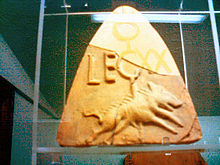
A Roman antefix roof
tile showing the badge and standard of Legio
XX Valeria Victrix, one of the legions that joined
Carausius’ rebellion
Although most of Gaul was pacified, regions bordering the English Channel still
suffered from Frankish and Saxon piracy.
The emperors Probus and Carinus had begun to fortify the Saxon
Shore, but much remained to be done. For
example, there is no archaeological evidence of naval bases at Dover and Boulogne during
270–285. In response to the pirate
problem, Maximian appointed Mausaeus Carausius,
a Menapian from Germania
Inferior (southern and
western Netherlands)
to command the Channel and to clear it of raiders.
Carausius fared well, and by
the end of 285 he was capturing pirate ships in great numbers.
Maximian soon heard that Carausius was waiting until the pirates had finished
plundering before attacking and keeping their booty himself instead of returning
it to the population at large or into the imperial treasury. Maximian
ordered Carausius’ arrest and execution, prompting him to flee to Britain.
Carausius’ support among the British was strong, and at least two British
legions (II
Augusta and XX Valeria
Victrix) defected to him, as did some or all of a legion near Boulogne (probably XXX
Ulpia Victrix). Carausius
quickly eliminated the few remaining loyalists in his army and declared himself
Augustus.
Maximian could do little about the revolt. He had no fleet – he had given it to
Carausius – and was busy quelling the Heruli and the Franks. Meanwhile,
Carausius strengthened his position by enlarging his fleet, enlisting Frankish
mercenaries, and paying his troops well. By
the autumn of 286, Britain, much of northwestern Gaul, and the entire Channel
coast, was under his control. Carausius
declared himself head of an independent British state, an Imperium
Britanniarum and issued coin of a
markedly higher purity than that of Maximian and Diocletian, earning the support
of British and Gallic merchants. Even
Maximian’s troops were vulnerable to Carausius’ influence and wealth.
Maximian appointed
Augustus
Spurred by the crisis with Carausius, on April 1, 286, Maximian
took the title of Augustus. This
gave him the same status as Carausius – so the clash was between two Augusti,
rather than between an Augustus and a Caesar – and, in Imperial propaganda,
Maximian was proclaimed Diocletian’s brother, his equal in authority and
prestige. Diocletian could not have
been present at Maximian’s appointment, causing
Seeck to suggest that Maximian usurped the title and was only later recognized
by Diocletian in hopes of avoiding civil war. This suggestion has not won much
support, and the historian William Leadbetter has recently refuted it. Despite
the physical distance between the emperors, Diocletian trusted Maximian enough
to invest him with imperial powers, and Maximian still respected Diocletian
enough to act in accordance with his will.
In theory, the Roman Empire was not divided by the dual imperium. Though
divisions did take place – each emperor had his own court, army, and official
residences – these were matters of practicality, not substance. Imperial
propaganda from 287 on insists on a singular and indivisible Rome, a patrimonium
indivisum. As the panegyrist of
289 declares to Maximian: “So it is that this great empire is a communal
possession for both of you, without any discord, nor would we endure there to be
any dispute between you, but plainly you hold the state in equal measure as once
those two Heracleidae,
the Spartan
Kings, had done.” Legal
rulings were given and imperial celebrations took place in both emperors’ names,
and the same coins were issued in both parts of the empire.[ Diocletian
sometimes issued commands to Maximian’s province of Africa; Maximian could
presumably have done the same for Diocletian’s territory.
Campaigns
against Rhenish tribes
Campaigns in 286 and 287
Maximian realized that he could not immediately suppress Carausius and
campaigned instead against Rhenish tribes. These
tribes were probably greater threats to Gallic peace anyway and included many
supporters of Carausius. Although
Maximian had many enemies along the river, they were more often in dispute with
each other than in combat with the Empire. Few
clear dates survive for Maximian’s campaigns on the Rhine beyond a general range
of 285 to 288. While receiving the
consular fasces on
January 1, 287, Maximian was interrupted by news of a barbarian raid. Doffing
his toga and donning his armor, he marched against the barbarians and, although
they were not entirely dispersed, he celebrated a victory in Gaul later that
year.
Maximian believed the Burgundian and Alemanni tribes of the Moselle–Vosges region
to be the greatest threat, so he targeted them first. He campaigned using
scorched earth tactics, laying waste to their land and reducing their numbers
through famine and disease. After the Burgundians and Alemanni, Maximian moved
against the weaker Heruli and Chaibones. He cornered and defeated them in a
single battle. He fought in person, riding along the battle line until the
Germanic forces broke. Roman forces pursued the fleeing tribal armies and routed
them. With his enemies weakened from starvation, Maximian
launched a great invasion across the Rhine. He
moved deep into Germanic territory, bringing destruction to his enemies’
homelands and demonstrating the
superiority of Roman arms. By the
winter of 287, he had the advantage and the Rhenish lands were free of Germanic
tribesmen. Maximian’s panegyrist
declared: “All that I see beyond the Rhine is Roman.”

Flavius Constantius, Maximian’spraetorian
prefect and
husband to his daughter Theodora
Joint
campaign against the Alamanni
The following spring, as Maximian made preparations for dealing with Carausius,
Diocletian returned from the East. The
emperors met that year, but neither date nor place is known with certainty. They
probably agreed on a joint campaign against the Alamanni and a naval expedition
against Carausius.
Later in the year, Maximian led a surprise invasion of the Agri
Decumates – a region
between the upper Rhine and upper Danube deep within Alamanni territory – while
Diocletian invaded Germany via Raetia.
Both emperors burned crops and food supplies as they went, destroying the
Germans’ means of sustenance. They
added large swathes of territory to the Empire and allowed Maximian’s build-up
to proceed without further disturbance. In
the aftermath of the war, towns along the Rhine were rebuilt, bridgeheads
created on the eastern banks at such places as Mainz and Cologne, and a military
frontier was established, comprising forts, roads, and fortified towns. A
military highway through Tornacum (Tournai, Belgium),
Bavacum (Bavay,
France), Atuatuca Tungrorum (Tongeren,
Belgium), Mosae Trajectum (Maastricht,
Netherlands), and Cologne connected points along the frontier
Constantius, Gennobaudes, and resettlement
In early 288, Maximian appointed his praetorian prefect Constantius
Chlorus, husband of Maximian’s daughter Theodora, to lead a campaign
against Carausius’ Frankish allies. These Franks controlled the Rhine estuaries,
thwarting sea-attacks against Carausius. Constantius moved north through their
territory, wreaking havoc, and reaching the North
Sea. The Franks sued for peace and in the subsequent settlement
Maximian reinstated the deposed Frankish king Gennobaudes. Gennobaudes became
Maximian’s vassal and, with lesser Frankish chiefs in turn swearing loyalty to
Gennobaudes, Roman regional dominance was assured.
Maximian allowed a settlement of Frisii, Salian
Franks, Chamavi and
other tribes along a strip of Roman territory, either between the Rhine and Waal rivers
from Noviomagus (Nijmegen,
Netherlands) to Traiectum (Utrecht,
Netherlands) or near Trier. These
tribes were allowed to settle on the condition that they acknowledged Roman
dominance. Their presence provided a ready pool of manpower and prevented the
settlement of other Frankish tribes, giving Maximian a buffer along the northern
Rhine and reducing his need to garrison the region.
Later
campaigns in Britain and Gaul
Failed
expedition against Carausius

Carausius, rebel emperor of Roman
Britain
By 289, Maximian was prepared to invade Carausius’ Britain, but for some reason
the plan failed. Maximian’s panegyrist of 289 was optimistic about the
campaign’s prospects, but the panegyrist of 291 made no mention of it. Constantius’
panegyrist suggested that his fleet was lost to a storm, but
this might simply have been to diminish the embarrassment of defeat. Diocletian
curtailed his Eastern province tour soon after, perhaps on learning of
Maximian’s failure. Diocletian
returned in haste to the West, reaching Emesa by May 10, 290, and
Sirmium on the Danube by July 1, 290.
Diocletian met Maximian in Milan either in late December 290 or January 291. Crowds
gathered to witness the event, and the emperors devoted much time to public
pageantry. Potter, among others, has
surmised that the ceremonies were arranged to demonstrate Diocletian’s
continuing support for his faltering colleague. The rulers discussed matters of
politics and war in secret, and they
may have considered the idea of expanding the imperial college to include four
emperors (theTetrarchy). Meanwhile,
a deputation from the Roman Senate met with the rulers and renewed its
infrequent contact with the imperial office. The
emperors would not meet again until 303.
Following Maximian’s failure to invade in 289, an uneasy truce with Carausius
began. Maximian tolerated Carausius’ rule in Britain and on the continent but
refused to grant the secessionist state formal legitimacy. For his part,
Carausius was content with his territories beyond the Continental coast of Gaul. Diocletian,
however, would not tolerate this affront to his rule. Faced with Carausius’
secession and further challenges on the Egyptian, Syrian, and Danubian borders,
he realized that two emperors were insufficient to manage the Empire. On
March 1, 293 at Milan, Maximian appointed Constantius to the office of Caesar. On
either the same day or a month later, Diocletian did the same for Galerius,
thus establishing the “Tetrarchy”, or “rule of four”. Constantius
was made to understand that he must succeed where Maximian had failed and defeat
Carausius.
Campaign against
Allectus

Allectus, Carausius’ successor
Constantius met expectations quickly and efficiently and by 293 had expelled
Carausian forces from northern Gaul. In the same year, Carausius was
assassinated and replaced by his treasurer, Allectus. Constantius
marched up the coast to the Rhine and Scheldt estuaries where he was victorious
over Carausius’ Frankish allies, taking the title Germanicus
maximus. His sights now set on
Britain, Constantius spent the following years building an invasion fleet. Maximian,
still in Italy after the appointment of Constantius, was apprised of the
invasion plans and, in the summer of 296, returned to Gaul. There,
he held the Rhenish frontiers against Carausius’ Frankish allies while
Constantius launched his invasion of Britain. Allectus
was killed on the North
Downs in battle with
Constantius’ praetorian prefect, Asclepiodotus.
Constantius himself had landed near Dubris (Dover)
and marched on Londinium (London),
whose citizens greeted him as a liberator.
Campaigns in North
Africa
With Constantius’ victorious return, Maximian was able to focus on the conflict
in Mauretania (Northwest
Africa). As Roman
authority weakened during the third century, nomadic Berber tribes harassed
settlements in the region with increasingly severe consequences. In 289, the
governor of Mauretania
Caesariensis (roughly
modern Algeria)
gained a temporary respite by pitting a small army against the Bavares and Quinquegentiani,
but the raiders soon returned. In 296, Maximian raised an army, from Praetorian
cohorts, Aquileian,
Egyptian, and Danubian legionaries, Gallic and German auxiliaries,
and Thracian recruits,
advancing through Spain that autumn. He
may have defended the region against raiding Moors before
crossing the Strait
of Gibraltar into Mauretania
Tingitana (roughly modern Morocco)
to protect the area from Frankish pirates.
By March 297, Maximian had begun a bloody offensive against the Berbers. The
campaign was lengthy, and Maximian spent the winter of 297–298 resting in Carthage before
returning to the field. Not content
to drive them back into their homelands in the Atlas
Mountains – from which
they could continue to wage war – Maximian ventured deep into Berber territory.
The terrain was unfavorable, and the Berbers were skilled at guerrilla
warfare, but Maximian pressed on. Apparently wishing to inflict as
much punishment as possible on the tribes, he devastated previously secure land,
killed as many as he could, and drove the remainder back into the Sahara. His
campaign was concluded by the spring of 298 and, on March 10, he made a
triumphal entry into Carthage. Inscriptions
there record the people’s gratitude to Maximian, hailing him – as Constantius
had been on his entry to London – as redditor
lucis aeternae (“restorer of the
eternal light”). Maximian returned to
Italy in 299 to celebrate another triumph in Rome in the spring.
Leisure and retirement
After his Mauretanian campaign, Maximian returned to the north of Italy, living
a life of leisure in palaces in Milan and Aquilea, and leaving warfare to his
subordinate Constantius. Maximian was
more aggressive in his relationship with the Senate than Constantius, and
Lactantius contends that he terrorized senators, to the point of falsely
charging and subsequently executing several, including the prefect of Rome in
301/2. In contrast, Constantius kept
up good relations with the senatorial aristocracy and spent his time in active
defense of the empire. He took up arms against the Franks in 300 or 301 and in
302 – while Maximian was resting in Italy – continued to campaign against
Germanic tribes on the Upper Rhine.
Maximian was only disturbed from his rest in 303 by Diocletian’s vicennalia,
the 20-year anniversary of his reign, in Rome. Some evidence suggests that it
was then that Diocletian exacted a promise from Maximian to retire together,
passing their titles as Augusti to the Caesars Constantius and Galerius. Presumably
Maximian’s son Maxentius and
Constantius’ son Constantine –
children raised in Nicomedia together
– would then become the new Caesars. While Maximian might not have wished to
retire, Diocletian was still in control and there was little resistance. Before
retirement, Maximian would receive one final moment of glory by officiating at
the Secular
Games in 304.
On May 1, 305, in separate ceremonies in Milan and Nicomedia, Diocletian and
Maximian retired simultaneously. The succession did not go not entirely to
Maximian’s liking: perhaps because of Galerius’ influence, Severus and Maximinus were
appointed Caesar, thus excluding Maxentius. Both the newly appointed Caesars had
had long military careers and were close to Galerius: Maximinus was his nephew
and Severus a former army comrade. Maximian
quickly soured to the new tetrarchy, which saw Galerius assume the dominant
position Diocletian once held. Although Maximian led the ceremony that
proclaimed Severus as Caesar, within two years he was sufficiently dissatisfied
to support his son’s rebellion against the new regime. Diocletian
retired to the expansive palace he
had built in his homeland, Dalmatia near Salona on the Adriatic.
Maximian retired to villas in Campania or Lucania,
where he lived a life of ease and luxury. Although
far from the political centers of the Empire, Diocletian and Maximian remained
close enough to stay in regular contact.
Maxentius’ rebellion
After the death of Constantius on July 25, 306, Constantine assumed the title of
Augustus. This displeased Galerius, who instead offered Constantine the title of
Caesar, which Constantine accepted. The title of Augustus then went to Severus. Maxentius
was jealous of Constantine’s power, and on October 28, 306, he persuaded a
cohort of imperial guardsmen to declare him as Augustus. Uncomfortable with sole
leadership, Maxentius sent a set of imperial robes to Maximian and saluted him
as “Augustus for the second time”, offering him theoretic equal rule but less
actual power and a lower rank.
Galerius refused to recognize Maxentius and sent Severus with an army to Rome to
depose him. As many of Severus’ soldiers had served under Maximian, and had
taken Maxentius’ bribes, most of the army defected to Maxentius. Severus fled to Ravenna,
which Maximian besieged. The city was strongly fortified so Maximian offered
terms, which Severus accepted. Maximian then seized Severus and took him under
guard to a public villa in southern Rome, where he was kept as a hostage. In the
autumn of 307, Galerius led a second force against Maxentius but he again failed
to take Rome, and retreated north with his army mostly intact.

Dresden bust of Maxentius
While Maxentius built up Rome’s defenses, Maximian made his way to Gaul to
negotiate with Constantine. A deal was struck in which Constantine would marry
Maximian’s younger daughter Fausta and be elevated to Augustan rank in Maxentius’
secessionist regime. In return, Constantine would reaffirm the old family
alliance between Maximian and Constantius, and support Maxentius’ cause in Italy
but would remain neutral in the war with Galerius. The deal was sealed with a
double ceremony in Trier in the late summer of 307, at which Constantine married
Fausta and was declared Augustus by Maximian.
Maximian returned to Rome in the winter of 307–8 but soon fell out with his son
and in the spring of 308 challenged his right to rule before an assembly of
Roman soldiers. He spoke of Rome’s sickly government, disparaged Maxentius for
having weakened it, and ripped the imperial toga from Maxentius’ shoulders. He
expected the soldiers to recognize him but they sided with Maxentius, and
Maximian was forced to leave Italy in disgrace.
On November 11, 308, to resolve the political instability, Galerius called
Diocletian (out of retirement) and Maximian to a general council meeting at the
military city of Carnuntum on the upper Danube. There, Maximian was forced to
abdicate again and Constantine was again demoted to Caesar, with Maximinus the
Caesar in the east. Licinius,
a loyal military companion to Galerius, was appointed Augustus of the West In
early 309 Maximian returned to the court of Constantine in Gaul, the only court
that would still accept him. After
Constantine and Maximinus refused to be placated with the titles of Sons
of the Augusti, they were promoted in early 310, with the result that there
were now four Augusti.
Rebellion against
Constantine
In 310, Maximian rebelled against Constantine while the Emperor was on campaign
against the Franks. Maximian had been sent south to Arles with part of
Constantine’s army to defend against attacks by Maxentius in southern Gaul. In
Arles, Maximian announced that Constantine was dead and took up the imperial
purple. In spite of offering bribes to any who would support him as
emperor, most of Constantine’s army remained loyal, and Maximian was compelled
to leave. Constantine soon heard of the rebellion, abandoned his campaign
against the Franks, and moved quickly to southern Gaul, where he confronted the
fleeing Maximian at Massilia (Marseille).
The town was better able to withstand a long siege than Arles, but it made
little difference as loyal citizens opened the rear gates to Constantine.
Maximian was captured, reproved for his crimes, and stripped of his title for
the third and last time. Constantine granted Maximian some clemency but strongly
encouraged his suicide. In July 310, Maximian hanged himself.
Despite the earlier rupture in relations, after Maximian’s suicide Maxentius
presented himself as his father’s devoted son. He
minted coins bearing his father’s deified image and proclaimed his desire to
avenge his death.
Constantine initially presented the suicide as an unfortunate family tragedy. By
311, however, he was spreading another version. According to this, after
Constantine had pardoned him, Maximian planned to murder Constantine in his
sleep. Fausta learned of the plot and warned Constantine, who put a eunuch in
his own place in bed. Maximian was apprehended when he killed the eunuch and was
offered suicide, which he accepted. In
addition to the propaganda, Constantine instituted a damnatio
memoriae on Maximian,
destroying all inscriptions referring to him and eliminating any public work
bearing his image.
Constantine defeated Maxentius at the Battle
of the Milvian Bridge on
October 28, 312. Maxentius died, and Italy came under Constantine’s rule. Eutropia
swore on oath that Maxentius was not Maximian’s son, and Maximian’s memory was
rehabilitated. His apotheosis under
Maxentius was declared null and void, and he was re-consecrated as a god,
probably in 317. He began appearing on Constantine’s coinage as divus,
or divine, by 318, together with the deified Constantius and Claudius
Gothicus. The three were
hailed as Constantine’s forbears. They were called “the best of emperors”. Through
his daughters Fausta and Flavia, Maximian was grandfather or great-grandfather
to every reigning emperor from 337 to 363.
|















